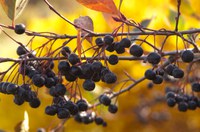Dakota Gardener: North Dakota’s Top Fruit is a Secret Wonder
(Click an image below to view a high-resolution image that can be downloaded)
By Tom Kalb, Horticulturist
NDSU Extension
What is the leading fruit crop grown in North Dakota?
You probably never heard of it.
Our top fruit is aronia, also known as black chokeberry.
The latest agriculture census showed aronia was grown on 88 acres in North Dakota in 2017. This was more land than our next two leading crops, apples and grapes, combined.
Aronia has emerged as the No. 1 fruit crop in our state because it is easy to grow. It’s gaining in popularity among backyard gardeners, too.
Aronia suffers from no major insect pests. This makes it a popular crop among organic growers and consumers.
The production of aronia is reliable. The shrubs survive our bitterly cold winters. The flowers do not appear until late May, escaping damage from killing frosts in late spring.
Birds are usually a major threat when growing fruit crops but not with aronia. Birds are not interested in eating aronia when it ripens in early September. In natural settings where fruits are not harvested, birds wait until winter to eat aronia berries.
No plant can completely stop a hungry deer, but aronia gives off natural chemicals that repel deer.
Fruit growers are worried about declining populations of bees, but aronia flowers do not need pollinators to set their fruits.
Best of all, aronia shrubs are precocious and productive. You can expect yields of 5 pounds or more after only three years. Irrigated plantings can achieve more than 15 pounds of berries per year.
Aronia would make a wonderful addition to a home landscape for its beauty alone. The shrubs are filled with white blossoms in the spring and glossy green foliage in the summer. In the fall, the leaves develop intense orange, red and purple colors.
Aronia is awesome. Then why doesn’t everyone grow it?
The raw fruits taste awful. These berries have a dry taste, hence its name “chokeberry.”
Aronia is much more popular in Europe, where consumers greatly appreciate its nutritional qualities.
Aronia is one of the richest sources of antioxidants among all fruits in the world. Medical studies have indicated the consumption of aronia has numerous health benefits that include reducing the risks of heart diseases and cancer.
Europeans overcome the dryness of the fruits by processing or freezing them. Aronia commonly is processed and made into juices, syrups, preserves and wines. Frozen fruits are baked into breads and used as toppings on ice cream, yogurt and oatmeal.
You can find aronia plants at many landscape nurseries today. ‘Viking’ and ‘Nero’ are the most popular varieties grown for fruit production. These shrubs grow about 6 feet tall and produce large clusters of fruits.
‘Autumn Magic’ and ‘Iroquois Beauty’ are varieties with more compact plants, smaller fruits and exceptional fall color. These varieties were developed to add beauty to landscapes.
‘McKenzie’ was developed in North Dakota and is offered by our soil conservation districts for wildlife plantings. These shrubs grow 8 to 10 feet tall.
Discover aronia. This easy-to-grow fruit can be a beautiful addition to your landscape.
For more information about gardening, contact your local NDSU Extension agent. Find the Extension office for your county at https://www.ag.ndsu.edu/extension/directory/counties.
NDSU Agriculture Communication - June 8, 2021
Source: Tom Kalb, 701-328-9722, tom.kalb@ndsu.edu
Editor: Ellen Crawford, 701-231-5391, ellen.crawford@ndsu.edu




